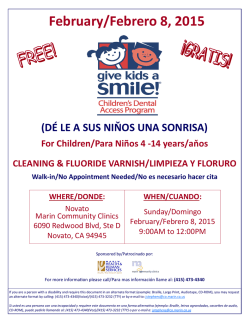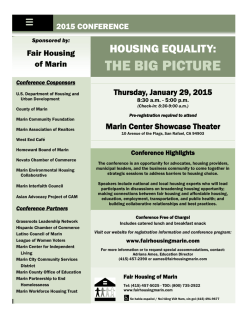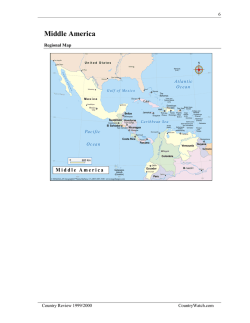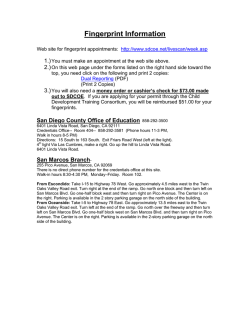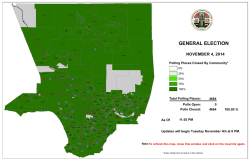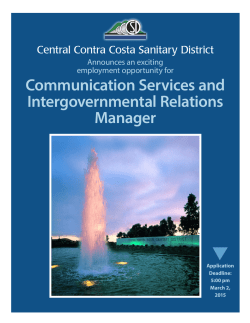
Harm, Costs, Policies, & Community Resources
MARIN COUNTY’S ALCOHOL ENVIRONMENT: Harm, Costs, Policies, & Community Resources A Report from Alcohol Justice and the San Rafael Alcohol & Drug Coalition | July 2015 MARIN COUNTY’S ALCOHOL ENVIRONMENT: Harm, Costs, Policies, & Community Resources EXECUTIVE SUMMARY Based on a variety of socio-demographic factors, Marin County is thriving; its population is relatively affluent, well-educated, and healthy. However, its environment with regard to alcohol places its residents, particularly youth, at risk. Marin County is saturated with alcohol, and the resulting harm is a major public health concern with significant health and economic impacts. Outlet density rates in Marin County are higher than the state average and exceed the California Department of Alcohol Beverage Control’s maximum recommended concentration. With 924 licensed sales outlets, there is one location selling alcohol for every 280 residents, and one location for every 67 youth under the legal drinking age. Nonetheless, additional alcohol licenses are approved every year. Cheap, youth-friendly alcohol products are sold at a majority of food outlets. Both adult and youth consumption rates are higher than the state average. Marin County also experiences a great deal of alcohol-related harm, including the following: n Admissions for treatment for alcohol as a primary substance and alcohol-related emergency room visits are higher in Marin County than statewide averages. n One out of ten motor vehicle crashes and 37% of crash fatalities in Marin County are alcohol-related. n Each year, the estimated economic cost experienced by Marin County is $214.7 million, including $92.2 million in direct costs to government. In order to reduce problems in its alcohol environment and alcohol-related harm, Marin County must employ evidence-based policies. These include limits on alcohol outlet density; increased enforcement of underage drinking laws; local levies to fund enforcement, treatment, and prevention; and bans on sales of dangerous, youth-oriented beverage products such as alcopops (i.e., flavored malt beverages). We hope this report will prove helpful in establishing the need for, and motivating movement toward, adopting specific alcohol policies to reduce excessive consumption and alcohol-related harm. It is intended to provide useful, current data for policymakers, community organizations, parents, educators, elected officials, and anyone with an interest in the health and safety of Marin County residents with regard to alcohol. Please contact Jorge Castillo, Alcohol Justice Advocacy Director ([email protected]), if you are interested in reducing alcohol-related harm in Marin County. 2 A Report from Alcohol Justice and the San Rafael Alcohol & Drug Coalition | July 2015 INTRODUCTION Marin County, California, is considered by many as an idyllic place to live, and has consistently ranked as the healthiest county in the state on a variety of physical and socioeconomic factors.1 Marin County is affluent, with a median household income of $96,580. It has a low poverty level, with 8.4% of the entire population and 9.5% of children under 18 with income below the poverty level.2 Marin County residents are also well-educated: 94% of its residents are high school graduates and 55% are college graduates. A notable exception to Marin County’s reputation of overall health is its high rates of risky alcohol use among adult and youth residents. Between 2006-2012, the excessive drinking 3 rate among current adult drinkers in Marin County averaged 22%, compared to 17% statewide, ranking Marin County 44th out of 51 counties. Forty-one percent of high school juniors in Marin County reported consuming alcohol in the past 30 days, and 30% reported binge drinking.4 An estimated 59,680 youth under the minimum legal drinking age of 21 live in Marin County, comprising 23% of the total estimated population. Marin County’s high drinking rates are located within an over-concentration of places selling alcohol, and ubiquitous access to cheap, youth-oriented products, creating an environment that surrounds youth with risk of alcohol-related harm. Harm resulting from alcohol use is a major public health concern in Marin County, with significant health and economic impacts. Environmental factors such as the number of alcohol establishments in an area (outlet density), the amount and types of alcohol advertising, and the price of alcohol, strongly influence both drinking behaviors and resulting harm. Enacting, maintaining, and enforcing evidence-based policies are the most effective steps to creating an environment that supports health and reduces harm. The most effective alcohol policies include: limits on access to and availability of alcohol, including restrictions on outlet density, hours, and days of sale; increases in the price of alcohol through taxes; enhanced enforcement of underage sales laws; 5 and restrictions on alcohol advertising and promotion.6, 7, 8 There is also evidence to support limiting specific problematic products such as single-serve alcoholic beverages and alcopops.9, 10 Strengthening alcohol policies and their enforcement, with community-based support and a focus on youth, would create a safer environment for public health and safety and could have a significant impact on consumption and related harm in Marin County. THE ALCOHOL ENVIRONMENT IN MARIN COUNTY OUTLET DENSITY Areas with higher concentration of licensed alcohol outlets experience more alcohol problems, including higher rates of consumption, violence, drunk driving, alcohol-related collisions, and youth access to alcohol.11 The California Department of Alcoholic Beverage Control (ABC) specifies that the general ratio of on-sale outlets such as bars, nightclubs, and restaurants should not exceed one alcohol outlet for every 2,000 county residents, and for off-sale outlets (retail sales such as liquor and grocery stores), one beer and wine license and one general off-sale license for every 2,500 population.12 Yet in Marin County, the ABC and local governments have allowed alcohol outlet density at rates four times more than the ABC specifies for on-sale licenses, and exceeding the ABC-recommended maximum of off-sale licenses by 16%. A Report from Alcohol Justice and the San Rafael Alcohol & Drug Coalition | July 2015 3 As of January 2015: n The ratio of active on-sale licenses to Marin County residents was one license to 379 residents; for off-sale licenses the ratio is one license for 1,074 residents, the maximum authorized by the ABC. n There were 241 off-sale active and pending licenses in Marin County, a concentration of 1.16 per 1,250 residents; California’s rate is .97 per 1,250 residents. n There were 683 active on-sale licenses, for an overall on-sale outlet density concentration of 5.28 outlets for every 2,000 residents in Marin County, compared to California’s 2.97. n Most of the Marin County on-sale licenses are eating places (488); 83 are bars, clubs, or pubs; and 112 are other types, including catering and instructional tasting licenses. n In 2012-2013, over half of those arrested for DUI in Marin County described their last place of drink as a bar or restaurant.13 RETAIL ENVIRONMENT The retail environment for alcohol includes promotions, advertising, location, placement, amount, and types of alcohol products available inside and outside of stores. An oversaturated retail environment increases exposure to messages promoting alcohol as well as the products, and increases the risk of excessive consumption, particularly for youth: 4 n A 2014 survey of 122 stores in the county found that 61% sold alcohol; of those, 75% sold alcopops (sweet, youth-oriented, flavored malt beverages); 33% had alcohol ads near candy or toys, or below 3 feet high; and 36% had exterior alcohol advertising.14 n A 2012 Alcohol Justice pricing survey of 7-Eleven stores in Marin County found that supersized alcopops, some containing the equivalent of 4.5 beers in one container, were cheaper per standard drink than beer and non-alcoholic energy drinks.15 A Report from Alcohol Justice and the San Rafael Alcohol & Drug Coalition | July 2015 ALCOHOL- RELATED HARM Average Annual Alcohol-attributable, Non-fatal Hospitalization and Emergency Department Visit Rates Per 100,000 Population, 2009-2013 DEATHS, INJURIES, AND ILLNESSES Rate Per 100,000 From 2008-2012, between 24 and 35 alcoholattributable deaths occurred each year in Marin County. The average rate per 100,000 population was similar to the statewide rate: 11.47 in California, and 11.26 in Marin County.16, 17 1000 800 836.2 600 400 517.3 653.2 488.7 200 0 California Marin From 2009-2013, Marin County saw an average Hospitalizations Emergency cy Department Depar ment Vis Visits of 1,244 alcohol-related non-fatal hospitalizations each year, and 2,129 emergency department visits. Over the five-year period, average rates of non-fatal hospitalizations were slightly lower than in California. However, the average rate of non-fatal emergency department visits was 22% higher than the statewide rate.18 ADMISSIONS FOR ALCOHOL TREATMENT Average substance abuse treatment admission rates for alcohol as a primary substance were higher in Marin County than in California; however, when all alcohol-related admissions were considered, the rates were comparable. The Marin County five-year average adult treatment admission rate through 2013 for alcohol as a primary substance was 104 adults per 100,000, compared to a four-year statewide average though 2012 of 87 adults per 100,000.19 The adult treatment admission rate for alcohol as a secondary substance in Marin County was 49 adults per 100,000 compared to the statewide rate of 67. For the combined admission rates of alcohol as primary and secondary substance, the average Marin County rate was 153 adults per 100,000 compared to 154 statewide.20, 21, 22 Average Admissions to Substance Use Treatment for Alcohol, Marin County, 2009-2013 (Adults 18+) Total Alcohol Admissions Alcohol as Primary Substance Alcohol as Secondary Substance Average Number 309 209 100 Average Rate / 100,000 Adults 153 104 49 MOTOR VEHICLE CRASHES Marin County has fared slightly better than the state in terms of overall rates of alcohol-impaired motor vehicle crashes, injuries, and deaths. Even so, one of every ten motor vehicle collisions, and an average of 37% of traffic fatalities in Marin County, is alcohol-related. Between 2009 and 2013: 23 n Alcohol-related crashes averaged 270 per year, including one to five fatalities and an average of 124 injuries each year. n The average annual rate of alcohol-related crashes per 100,000 residents was 106.3 in Marin, slightly lower than California at 113.6. A Report from Alcohol Justice and the San Rafael Alcohol & Drug Coalition | July 2015 5 ALCOHOL - RELATED ARRESTS Alcohol is a contributing factor in an estimated 40% of violent crime, and approximately 36% of convicted offenders were under the influence of alcohol at the time of their crimes.24 At the community level, arrests for crimes specifically involving alcohol violations help indicate the level of enforcement and add context to estimates of consumption. Between 2009 and 2013, arrest rates for drunkenness and liquor law violations, and for DUI arrests, dropped precipitously in Marin County and statewide. It is unclear whether the drop is due to changes in enforcement, drinking patterns, other factors, or a combination of factors.25 For felony and misdemeanor DUI arrests per 100,000 population adults age 20 and older, Marin County decreased from 760 to 626; California from 756 to 557. For youth age 10-19, the Marin County rate dropped from 295 to 113; statewide, from 205 to 115. Youth Drunk / Liquor Arrest Rates, Marin County and California, 2009-2013 Arrest Rate Per 100,000 Population at Risk For drunkenness and liquor law violations per 100,000 adults age 20 and older, Marin County dropped from 497 to 367, and California from 424 to 333. Among youth age 10-19, the Marin County rate decreased from 1144 to 194; statewide, from 417 to 223. 1400 1200 1000 800 600 400 200 0 2009 2010 2011 2012 2013 Drunk/Liquor Laws – Calif. 417 376 333 281 223 Drunk/Liquor Laws – Marin 1144 995 857 605 194 DUI – California 205 179 155 140 115 DUI – Marin 295 207 169 159 113 ECONOMIC COSTS Excessive alcohol consumption costs California a conservatively estimated $31.9 billion in economic harm each year, a per capita cost of $874.26 These figures include a direct cost to government of $13.7 billion, including costs for health care (e.g. alcohol-attributable Annual Economic Cost of Excessive injuries, deaths, treatment, illnesses, and fetal alcohol Consumption in Marin Co. (in millions) syndrome), crime prevention, and criminal justice costs. Lost productivity includes costs for alcohol dependence, incarceration, and absenteeism. Total Annual Cost Based on the California cost figures and the Marin population, the estimated economic cost experienced by Marin County is $214.7 million annually, including $92.2 million in direct costs to government. Binge drinking Underage drinking Lost productivity Health care 6 $214.7 Direct government cost A Report from Alcohol Justice and the San Rafael Alcohol & Drug Coalition $92.2 $158.7 $23.4 $160.9 $20.3 | July 2015 ALCOHOL PROBLEMS AND MARIN YOUTH Reducing alcohol consumption among youth is critical. Drinking is a major cause of death from injuries among underage youth, and the early onset of drinking increases the risk of alcohol-related problems later in life.27 Alcohol consumption among Marin County youth is high, and higher than the state average. In the 2013-14 academic year: 3, 28 n Marin County 9th-graders reported drinking at approximately the same rates as 9th-graders statewide. However, 11th-grader consumption exceeded the average state rates for past 30-day consumption and binge drinking. Have Had At Least One Drink of Alcohol in the Past 30 Days 35% 30% 25% 20% 15% 10% 5% 0% 50% 40% 41% 30% 20% 10% 33% 20% 20% 0% California 9th-Graders ad ders Have Engaged in Binge Drinking in the Past 30 Days 30% 22% 11% 10% California Marin 11th-Graders 1 1th-G G ers 9th-Graders aders Marin 11th-Graders 11th-G ers n Forty-five percent of 11th-graders in Marin County said they had been very drunk or sick after drinking alcohol, compared to 40% statewide. n 11th-graders in Marin County were more likely to obtain alcohol in a social setting than any other manner. While 43% said they did not drink alcohol, 23% got it from parties or events outside of school; 17% got it from friends or another teenager at their home; and 3% got it at school or school events. n 9th- and 11th-graders in Marin County were more likely to say that obtaining alcohol is “very easy” or “fairly easy” than 9th- and 11th-graders from the entire statewide sample. Perceive Alcohol as Very Easy or Easy to Obtain 100% 80% 60% 40% 56% 72% 64% 78% 20% 0% California 9th-Graders aders Marin 11th-Graders 11th-G ers A Report from Alcohol Justice and the San Rafael Alcohol & Drug Coalition | July 2015 7 CONCLUSION The alcohol environment in Marin County puts both youth and adult residents at high risk for alcoholrelated harm. To help stem the dangerous consumption and resulting harms described in this report, communities can enact policies that positively and effectively change the environment. Such policies include reductions in access and availability to alcohol; limits on advertising and promotion; and increased enforcement of underage drinking laws. Specifically, the following policy recommendations may be considered: 4, 29 8 n Limits on new alcohol licenses, including conditional use permits, zoning restrictions, deemed approved ordinances, and mandatory local rules on findings of public convenience and necessity; n Funding for increased enforcement of underage drinking laws; n Enforcement of retail compliance with advertising, promotion, and other city, county and ABC codes; n New ordinances to prohibit sales of dangerous or problem products, such as alcopops, single-serving beverages, and malt liquor; and n Local taxes on alcoholic beverages to fund enforcement, prevention, and treatment. A Report from Alcohol Justice and the San Rafael Alcohol & Drug Coalition | July 2015 WAYS TO GET INVOLVED: n Contact your local prevention coalition (listed on following page) to find out more about efforts to improve alcohol policy and enforcement in Marin County. n Support local retailers enforcing legal drinking age laws. Report violations to the California ABC and local police. n Ask local retailers in Marin County to voluntarily stop selling youth-oriented alcohol products such as alcopops/flavored malt beverages, malt liquor, supersized and single-serving containers. n Support resolutions to make Marin County an Alcopop-Free Zone, such as those already passed by the Marin County Board of Supervisors and the City Councils in San Rafael, Novato, and Tiburon. More information is available at alcoholjustice.org and alcopopfreezone.us. n Contact Youth for Justice for more information about youth involvement in prevention at: [email protected], (415) 257-2488. n Contact Youth Leadership Institute for information on other youth involvement and empowerment activities such as Friday Night Live, at http://www.yli.org, (415) 455-1676. n Learn more about evidence-based prevention of excessive alcohol consumption and related harm. Visit The Guide to Community Preventive Services, www.thecommunityguide.org. A Report from Alcohol Justice and the San Rafael Alcohol & Drug Coalition | July 2015 9 LOCAL RESOURCES MARIN COUNTY ALCOHOL AND DRUG ADVISORY BOARD http://apps.marincounty.org/bosboardsandcomm/boardpage.aspx?BrdID=4 (415) 473-3020 MARIN COUNTY HEALTH & HUMAN SERVICES https://www.marinhhs.org/substance-use-services https://www.marinhhs.org/prevention-hub (415) 473-3030 COMMUNITY PREVENTION COALITIONS San Rafael Alcohol and Drug Coalition (Jorge Castillo) . . . . . . . . . . . . . . . . . . . . . . . . . (415) 257-2488 Healthy Novato . . . . . . . . . . . . . . . . . . . . . . . . . . . . . . . . . . . . . . . . . . . . . . . . . . . . . . . (415) 493-4322 Novato Blue Ribbon Coalition for Youth . . . . . . . . . . . . . . . . . . . . . . . . . . . . . . . . . . . . . (415) 899-8200 Ross Valley Coalition (Bridget Clark) . . . . . . . . . . . . . . . . . . . . . . . . . . . . . . . . . . . . . . . (415) 454-4404 San Rafael Alcohol Compliance Team . . . . . . . . . . . . . . . . . . . . . . . . . . . . . . . . . . . . . . (415) 473-4230 The West Marin Community Coalition for Healthy Kids. . . . . . . . . . . . . . . . . . . . . (415) 488-8888 x251 The Southern Marin Healthy Community Coalition . . . . . . . . . . . . . . . . . . . . . . . . . . . . (415) 383-1370 Twin Cities Coalition for Healthy Youth . . . . . . . . . . . . . . . . . . . . . . . . . . . . . . . . . . . . . (415) 927-5150 Communities Mobilized for Change on Alcohol . . . . . . . . . . . . . . . . . . . . . . . . . . . . . . . (415) 455-1676 10 A Report from Alcohol Justice and the San Rafael Alcohol & Drug Coalition | July 2015 REFERENCES 1 County Health Rankings 2015. University of Wisconsin Population Health Institute. http://www.countyhealthrankings.org/sites/default/files/state/downloads/CHR2015_CA_0.pdf. Accessed March 15, 2015. 2 2013 American Community Survey, 1-Year Estimates. U.S. Census Bureau. Accessed January 15, 2015. http://factfinder.census.gov/faces/tableservices/jsf/pages/productview.xhtml?pid=ACS_13_1YR_S0101&prodType=table. 3 Excessive alcohol use, as defined by the U.S. Centers for Disease Control and Prevention, includes binge drinking, heavy drinking, and any alcohol use by pregnant women or people under the minimum legal drinking age of 21. Heavy drinking is defined as more than 7 standard drinks per week for women, and more than 15 standard drinks per week for men. Binge drinking is defined as alcohol consumption resulting in a blood alcohol concentration level of .08% or higher; for women, this is typically 4 or more drinks in 2 hours, and for men, 5 or more drinks. 4 Marin County. California Healthy Kids Survey, 2013-14: Main Report. San Francisco: WestEd Health & Human Development Program for the California Department of Education. 5 Preventing Excessive Alcohol Consumption. Guide to Community Preventive Services. http://www.thecommunityguide.org/alcohol/index.html. Accessed January 18, 2015. 6 Center on Alcohol Marketing and Youth. Alcohol advertising and youth. http://www.camy.org/factsheets/index.php?FactsheetID=1. Accessed on March 15, 2015. 7 Anderson P, De Bruijn A, Angus K, et al. Special issue: the message and the media. Impact of alcohol advertising and media exposure on adolescent alcohol use: A systematic review of longitudinal studies. Alcohol Alcohol. 2009;44:229–243. 8 Babor T, Caetano R, Casswell S, et al. 2010. Alcohol: No ordinary commodity: Research and public policy. Oxford: Oxford University Press. 9 Parker RN, McCaffree K, Skiles D. Impact of Retail Practices on Violence: The Case of Single Serve Alcohol Beverage Containers. Drug and Alcohol Review. 2011;30(5):496-504. 10 Albers AB, Siegel M, Ramirez RL et al. Flavored Alcoholic Beverage Use, Risky Drinking Behaviors, and Adverse Outcomes Among Underage Drinkers: Results From the ABRAND Study. American Journal of Public Health: 2015; 105(4):810-815. doi: 10.2105/AJPH.2014.302349. 11 Alcohol Justice. Alcohol Outlet Density and Public Health. https://alcoholjustice.org/images/factsheets/OutletDensity2014.pdf. Accessed March 15, 2015. 12 Alcoholic Beverage Control Act Chapter 5, Article 2, sections 23815-23827. California Department of Alcoholic Beverage Control. http://www.abc.ca.gov/forms/ ABCAct_2009.pdf. Accessed January 15, 2015. 13 California Department of Alcoholic Beverage Control. License Query System: raw data export. http://www.abc.ca.gov/datport/SubscrMenu.asp. Accessed January 15, 2015. 14 Marin County Fact Sheet. Healthy Stores for a Healthy Community. http://www.healthystoreshealthycommunity.com/documents/counties/Marin%20County%20 Data.pdf. Published March 2014. Accessed March 15, 2015. 15 Alcohol Justice. Alcopops Cheaper than Energy Drinks: 7-11 Gambles with Children’s Lives. https://alcoholjustice.org/images/reports/711_final.pdf. Accessed March 15, 2015. 16 American Community Survey 1-Year Demographic and Housing Estimates. U.S. Census Bureau. Accessed January 15, 2015. Population estimates for 2014-2015: State of California, Department of Finance, Report P-3: State and County Population Projections by Race/Ethnicity, Detailed Age, and Gender, 2010-2060. Sacramento, California, December 2014. Accessed January 15, 2015. 17 EpiCenter California Injury Data Online: Alcohol and Other Drug Health Consequences. California Department of Public Health. http://epicenter.cdph.ca.gov/ReportMenus/AlcoholDrugTable.aspx. Accessed January 15, 2015. 18 Non-fatal hospitalizations and emergency department visits include all cases with a diagnosed alcohol or drug condition, whether diagnosed as the principal or secondary condition. Numbers are based on treatment episodes, not individuals. Therefore an individual may be counted more than once in the same year. Health consequences included poisoning injuries, mental disorders, and physical diseases. 19 The California average rate is based on years 2009-2912. The 2013 data were not yet available at the time of this publication. 20 This data represents admissions to agencies under contract with the Marin County Division of Alcohol, Drug and Tobacco Programs and is inclusive of individuals accessing County and/or non-County subsidized services. 21 California Outcomes Measurement System (CalOMS) Treatment Input Data File. California Department of Health Care Services Information Technology Web Services. Data provided by the Marin County Dept. of Health & Human Services, March 5, 2015. 22 Treatment Episode Data Set – Admissions (TEDS-A), 2009-2012. United States Department of Health and Human Services. Substance Abuse and Mental Health Services Administration. Center for Behavioral Health Statistics and Quality. ICPSR35037-v1. Ann Arbor, MI: Inter-university Consortium for Political and Social Research [distributor], 2014-05-07. http://doi.org/10.3886/ICPSR35037.v1 23 California Highway Patrol Statewide Integrated Traffic Records System (SWITRS). http://www.chp.ca.gov/switrs/index_menu.html. Accessed January 15, 2015. 24 National Council on Alcoholism and Drug Dependence, Inc. Alcohol and Crime. https://ncadd.org/images/stories/PDF/factsheet-alcoholandcrime.pdf. Accessed January 15, 2015. 25 Monthly Arrest and Citation Register, 2009-2013. State of California Department of Justice, Office of the Attorney General. https://oag.ca.gov/crime/cjsc/stats/arrests. Accessed January 15 , 2015. 26 Sacks JJ, Roeber J, Bouchery EE, et al. State Costs of Excessive Alcohol Consumption, 2006. Am J Prev Med 2013;45(4):474-485. 27 Alcohol Justice. Minimum Legal Drinking Age Saves Lives. https://alcoholjustice.org/images/factsheets/MLDA2014.pdf. Accessed March 15, 2015. 28 Student well-being and school climate in California, 2011-13. Statewide results of the Biennial Statewide California Healthy Kids Survey, Secondary school students. San Francisco: WestEd Health & Human Development Program for the California Department of Education. 29 Mosher JF, Treffers R. Best Practices in Municipal Regulation to Reduce Alcohol-Related Harms from Licensed Alcohol Outlets. Ventura County Behavioral Health, Alcohol & Drug Programs, Prevention Services. Available at: http://venturacountylimits.org/resource_documents/VC_BestPractAlcSales_Jan2014fnl.pdf. Accessed March 15, 2015. A Report from Alcohol Justice and the San Rafael Alcohol & Drug Coalition | July 2015 11 VISION We envision healthy communities free of the alcohol industry’s negative impact. MISSION We promote evidence-based public health policies and organize campaigns with diverse communities and youth against the alcohol industry’s harmful practices. BOARD OF DIRECTORS Anthony Ramirez, MA (President) Herb Kessner, PhD Tiffany E. Tan, MSD Captain John Hanley (Ret.) Ruben Rodriguez Andrew Riesenberg, MSPH Cathy Summa-Wolfe, MBA Allyn Taylor, LLM, JSD John Whitaker, Jr., CDS, CATC II EXECUTIVE DIRECTOR / CEO Bruce Lee Livingston, MPP SAN RAFAEL ALCOHOL & DRUG COALITION Marcianna Nosek Nick Moorhatch Michael Watenpaugh Sparkie Spaeth Kevin Lynch Mary Jo Williams ACKNOWLEDGMENTS Thank you to Catherine Condon and Kristen Law of Marin County Health and Human Services for providing data used in this report. Don Carney Gilmar Garcia Douglas Mundo Wilibaldo Pulido Elia Manzo Belsi Aguilar This is a joint report of Alcohol Justice and its project San Rafael Alcohol and Drug Coalition. The Coalition is funded by the Drug Free Communities Support Program of SAMHSA and ONDCP. 24 Belvedere Street San Rafael, California 94901 alcoholjustice.org A Report from Alcohol Justice and the San Rafael Alcohol & Drug Coalition Copyright © Alcohol Justice 2015 | July 2015
© Copyright 2025
